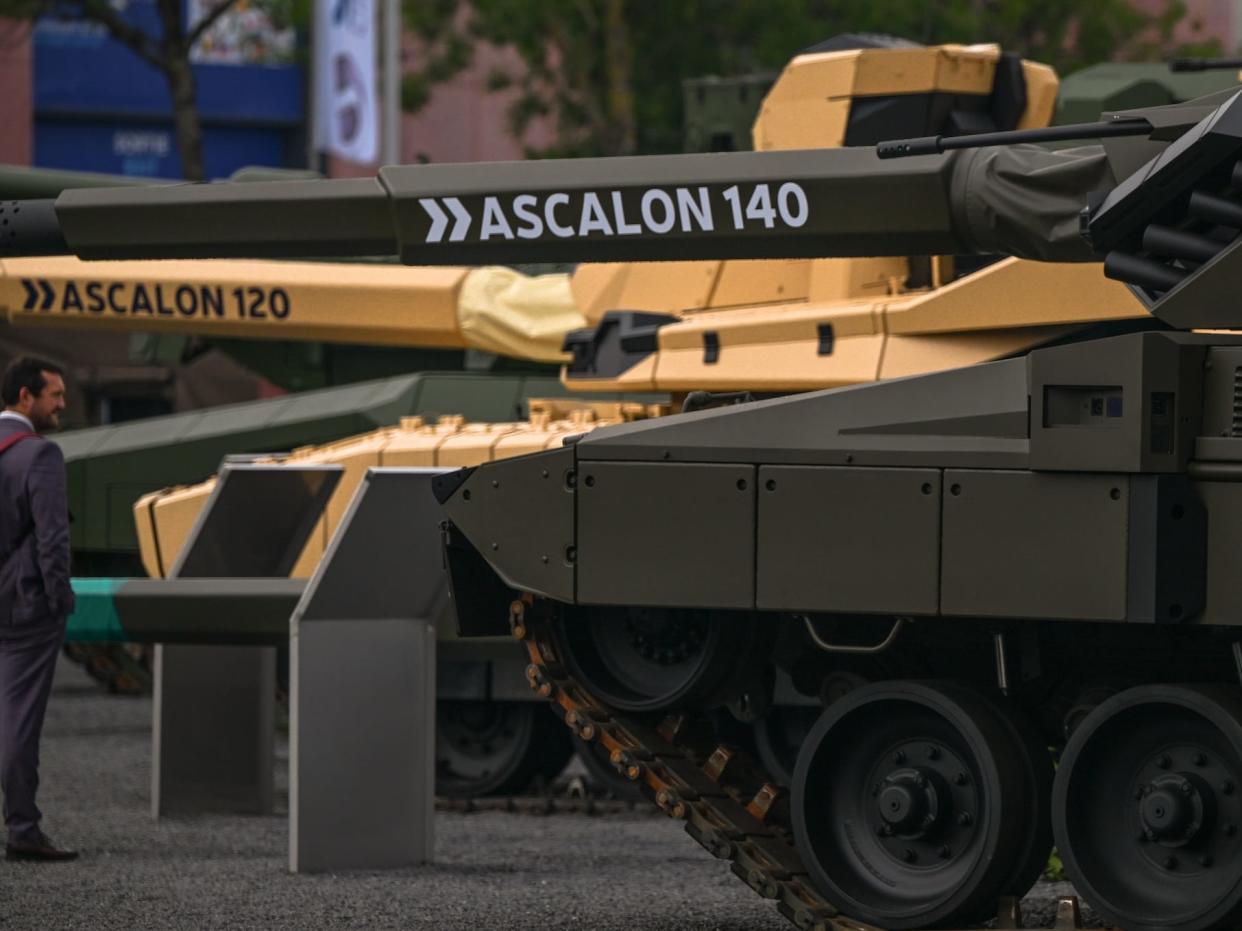Fierce competition for Europe's next-generation tanks shapes up

A slew of new tank designs are emerging from European drawing boards.
Many are alternatives to the pan-European tank envisioned by France and Germany.
It faces domestic pressure to favor national projects that benefit a nation's workforce.
For years, the European tank market was fairly stable. Germany's Leopard 2 was the most common model in European armies, with Britain, France, and Italy producing a small number of indigenous models for their own armies.
But a slew of new tank designs are emerging from European drawing boards. This is partly spurred by the Ukraine war, which has seen the most intense armored warfare in Europe since 1945. But it may also reflect a lack of faith in the Main Ground Combat System, a joint project between France and Germany to develop a main battle tank by 2040.
"It seems that every industrial partner is working on its own alternative to MGCS," Léo Péria-Peigné, a French defense expert, told Business Insider.
It was inevitable that a new generation of tanks would emerge to replace the late Cold War designs that still dominate Western armies, such as the Leopard 2, M1 Abrams, and Britain's Challenger. Even the US Army is aiming for a next-generation version of the M1 Abrams that would slim down the 70-ton behemoth to less than 60 tons.
MCGS is meant to replace the Leopard 2 and France's Leclerc as the primary tanks in the German and French armies. Both nations recently signed an agreement to begin development and manufacturing of a prototype. But at the same time, MGCS seemed like it might also replace the Leopard 2 as a sort of pan-European tank. MGCS is supposed to be a modular design with advanced features such as a 140-mm gun, hybrid propulsion, advanced sensors, and the ability to team up unmanned ground vehicles. A conceptual model displayed in 2018 used a Leopard 2 hull and a Leclerc turret.
However, there are indications that Germany wants a fallback design, based on the latest Leopard 2A8 model, in case MCGS fizzles out. "The Leopard 2AX, an improved version of the Leopard 2A8 battle tank, is being developed by the German defense industry at the express request of the Bundeswehr," according to Army Recognition, a defense news site.
"This development also serves as a Plan B for Germany in case of failure of the Franco-German program, or even as a lever in future negotiations, thus confronting France with a fait accompli regarding the crucial decisions that remain to be made," Army Recognition said.
Meanwhile, two new designs are being offered by KNDS, a joint venture between German defense firm Krauss-Maffei Wegmann — manufacturer of the Leopard 2 — and France's Nexter, which produces the Leclerc.
The Leopard 2 A-RC 3.0 is a modular design with an unmanned turret with the crew nestled in the hull, similar to Russia's T-14 Armata. It can fire guided missiles and heavy cannon rounds, plus it has a 30-mm cannon and improved armor buttressed by an active protection system to stop anti-tank rockets. Existing Leopard 2 models can also be fitted with these features.
Significantly, KNDS "assesses the Leopard 2 A-RC 3.0 not only as a bridge solution until introduction of the next-generation land combat system MGCS, but also as a decisive technological precursor to MGCS," according to a company press release.
KNDS is also touting the Leclerc Evolution, which is fitted with the company's Ascalon turret and gun. The company describes Ascalon as "a main gun for battle tanks that is more powerful than all comparable barrel weapons. It can fire compact and programmable ammunition beyond the line of sight with minimal wear. Due to its scalability, Ascalon can be fitted with any barrel from 120 to 140 mm."
As if the procurement picture wasn't complicated enough, four companies — KNDS Germany, KNDS France, Germany's Rheinmetall and France's Thales — have also just announced a joint venture to develop the MGCS. Yet Rheinmetall is also marketing its KF51 Panther tank, armed with a new 130-mm cannon. Hungary has signed a development contract for the Panther, which Rheinmetall has also offered to Ukraine.
Political turmoil in France has also cast a shadow over MGCS, with far-right parties favored to win the upcoming parliamentary election. "It seems that even the German government believes the MGCS project could be abandoned if the right takes power," Péria-Peigné said.
"Things will get clearer over time, but it is obvious that both partners are keeping alternative solutions up their sleeves. Germany did for a long time. The new surprise is that even KNDS France seems to have done the same."
European defense budgets are already being strained by the need to replenish depleted stockpiles, sending a constant flow of weapons and ammunition to Ukraine, and building up the manufacturing capacity to produce all these arms. This raises the question of whether there is enough money for all these various tank designs.
But the woes of MGCS also illustrate the problem that has always bedeviled joint European defense projects: the tension between saving money through joint development, versus domestic pressure to favor national projects that benefit a nation's manufacturers and workforce. If MGCS were to be abandoned, it would be a bad omen for the Future Combat Air System, a Franco-German-Spanish project to develop a sixth-generation fighter as well as air combat drones.
"Abandoning MGCS would be more of a burden for France than for Germany, as Germany does not need France to build a new tank," Péria-Peigné said. "Unlike in the FCAS, where France can do it alone technically but lacks the money to develop it alone."
Michael Peck is a defense writer whose work has appeared in Forbes, Defense News, Foreign Policy magazine, and other publications. He holds an MA in political science from Rutgers Univ. Follow him on Twitter and LinkedIn.
Read the original article on Business Insider


